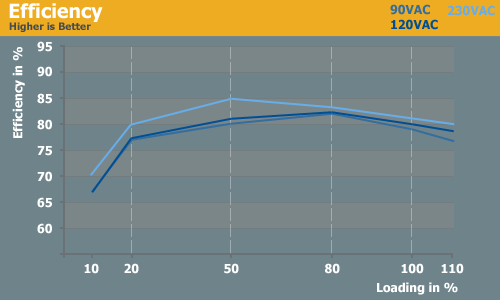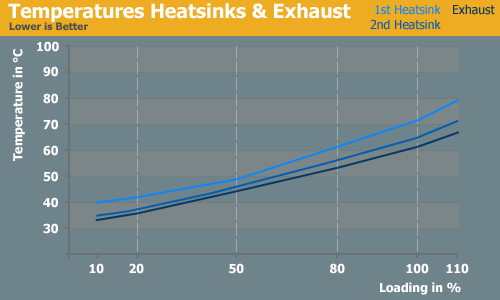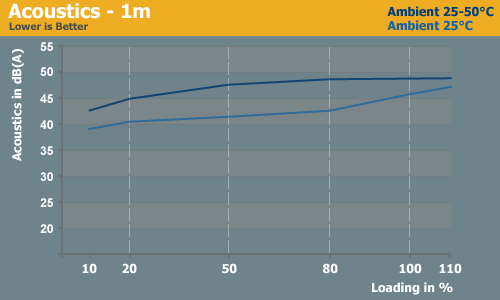Ultra High-End PSU Roundup
by Christoph Katzer on October 22, 2007 6:00 AM EST- Posted in
- Cases/Cooling/PSUs
PCP&C 1200W Efficiency, Temperatures, Fan Speed and Acoustics

With high input voltage the efficiency reaches up to 85% at a medium load of 600W. In general it always stays above 80% and doesn't go lower even at a 110% load. With lower input voltage such as 90 and 120VAC the levels are just average and only reach maximum efficiency at loads of around 900W - where it achieves a decent 83% efficiency. While 83% efficiency at 900W might be good, most systems that would require such a PSU will likely not be running at 900W load constantly. It should be possible to improve efficiency at other loads, but it seems likely that the unique design/layout PCP&C uses is playing a role.


During our first round of testing our temperature probe broke and we saw more than 1000°C on our thermometer. This is the second round of new probes we've had to install, a testament to the extreme conditions that can be found inside our testing chamber. Since the Turbo Cool has double the number of components of a "normal" power supply but also just "half" the load on each of the bridges, we actually expected the temperatures to be a little higher than we finally measured. Given there are three heat sinks, the primary in this graph is the top heat sink and by secondary we mean the two lower heat sinks.
The temperature delta from minimum to maximum load during testing is around 25°C at room temperature and as much as 40°C in the heat chamber. The temperature difference on the primary heat sink between the two environments starts at 5°C and reaches a maximum 18°C; this means that the primary heat sink is generally quite hot regardless of ambient temperature. Looking at the heat chamber testing, all of the measurements show a similar increase; this is good as it indicates the heat is at least getting out of the power supply and doesn't stick around to cook any of the components. To help make this possible PCP&C installed a Delta fan that can reach speeds of up to 4900 RPM.


We actually needed to extend our table to show the RPM of the Delta fan properly since we couldn't imagine finding a modern PSU with a fan that could almost hit 5000 RPM. Even at low temperatures we already measure almost 3500 RPM under room temperature. Starting with 30°C in the heat chamber the fan is already almost 1000 RPM higher. With these fan speeds the measured sound levels are hardly surprising. Please note the above measurements are taken at a distance of one meter! With its noise level of 50dB(A), this power supply tops even the Silencer 750 QUAD and is now the new leader of the non-silent power supplies faction. Once again, this loud fan is needed because there's no other reasonable way to get the heat out of the case with all the obstacles in the way of a proper airflow. High power with limited airflow pretty much necessitates the use of noisy cooling fans; this PSU would fit right in with many datacenter cooling racks.

With high input voltage the efficiency reaches up to 85% at a medium load of 600W. In general it always stays above 80% and doesn't go lower even at a 110% load. With lower input voltage such as 90 and 120VAC the levels are just average and only reach maximum efficiency at loads of around 900W - where it achieves a decent 83% efficiency. While 83% efficiency at 900W might be good, most systems that would require such a PSU will likely not be running at 900W load constantly. It should be possible to improve efficiency at other loads, but it seems likely that the unique design/layout PCP&C uses is playing a role.


During our first round of testing our temperature probe broke and we saw more than 1000°C on our thermometer. This is the second round of new probes we've had to install, a testament to the extreme conditions that can be found inside our testing chamber. Since the Turbo Cool has double the number of components of a "normal" power supply but also just "half" the load on each of the bridges, we actually expected the temperatures to be a little higher than we finally measured. Given there are three heat sinks, the primary in this graph is the top heat sink and by secondary we mean the two lower heat sinks.
The temperature delta from minimum to maximum load during testing is around 25°C at room temperature and as much as 40°C in the heat chamber. The temperature difference on the primary heat sink between the two environments starts at 5°C and reaches a maximum 18°C; this means that the primary heat sink is generally quite hot regardless of ambient temperature. Looking at the heat chamber testing, all of the measurements show a similar increase; this is good as it indicates the heat is at least getting out of the power supply and doesn't stick around to cook any of the components. To help make this possible PCP&C installed a Delta fan that can reach speeds of up to 4900 RPM.


We actually needed to extend our table to show the RPM of the Delta fan properly since we couldn't imagine finding a modern PSU with a fan that could almost hit 5000 RPM. Even at low temperatures we already measure almost 3500 RPM under room temperature. Starting with 30°C in the heat chamber the fan is already almost 1000 RPM higher. With these fan speeds the measured sound levels are hardly surprising. Please note the above measurements are taken at a distance of one meter! With its noise level of 50dB(A), this power supply tops even the Silencer 750 QUAD and is now the new leader of the non-silent power supplies faction. Once again, this loud fan is needed because there's no other reasonable way to get the heat out of the case with all the obstacles in the way of a proper airflow. High power with limited airflow pretty much necessitates the use of noisy cooling fans; this PSU would fit right in with many datacenter cooling racks.










27 Comments
View All Comments
redly1 - Monday, October 22, 2007 - link
I'm just trying to imagine the flames that ensue when something goes bad on the motherboard.Anyone ever burn up a classic Athlon by forgetting to put the heatsink on? Imagine doing that with a 1.3kW supply? Yikes
billa16 - Tuesday, October 23, 2007 - link
I did that on a k7@950. I was trying to oc it(hardmod with a pencil). Nothing happend the first 2 times(just a few secs). After that it's stopped working. No sparks/flames and stuff like that. Don't belive anything U read/see on the internet.This type of power supply's have protections. If something is damaged so bad that would cause flames the protection kicks in. The worst fire scenario with this type of PSU will be a flash when the fuse burns out.
Sorry for my poor english.
DigitalFreak - Monday, October 22, 2007 - link
Still amazes me how many people fall for the marketing hype...Traciatim - Monday, October 22, 2007 - link
Instead of just giving specs and doing an overview of the efficiency, why not design a machine that actually needs these over say a 600-700Watt PSU and show watt you would need to do do actually use one of these.I have a pretty small machine, and it regularly pulls 120Watts out of the wall, 200Watts if I Get everything ramped up. I'm also using a P4, not a Core2Duo so it's not going to be as efficient.
The ONLY point that I can see to have one of these is simply to waste money on uneeded equipment that could be better spent one something performance based and to say that 'My PSU is bigger than your PSU'.
retrospooty - Monday, October 22, 2007 - link
Ya, these 1000+ watt PSU's are marketed to enthusiests, and are supposed to be for heavily overclocked quad core CPU's (meaning cascade, dry ICE or liquid nitrogen cooling kind of overclocks) with overclocked high end SLI or crossfire rigs, and plenty of hard drives and other peripherals added as well. We are talking $3000 or higher systems - WAY overkill probably even for that purpose.JarredWalton - Monday, October 22, 2007 - link
You can see the most power-hungry system I've personally tested http://www.anandtech.com/systems/showdoc.aspx?i=30...">right here - which uses standard ATX components and a Topower PSU. That's a lot more system than most people run, obviously, but if maximum efficiency is achieved in the 40-80% load range, and if that particular PSU was around 80% efficient, it was outputting around 600W of power at maximum load.Toss in TriFire HD 2900 XT and you could add another 100W to that, maybe. If you were to get an overclocked Xeon platform with dual quad-core CPUs plus CrossFire/TriFire, you could actually reach the point where 1300W was "required". LOL
ORB chasers and "professional benchmarkers" running at insane overclocks (i.e. 5000 MHz quad-core) deal with exponential power requirement increases as well. The solution is either to use multiple PSUs or else get one of these uber-powerful designs. So these appear to be for around 0.01% of the market, I guess?
Michael91ah - Monday, October 22, 2007 - link
Glad to see the statistics for these 3 units. I really like the Cooler Master's curve on the acoustics. That noise makes a big difference for me when choosing a power supply.